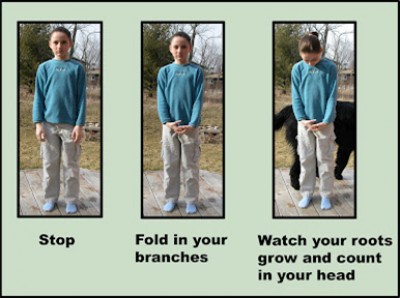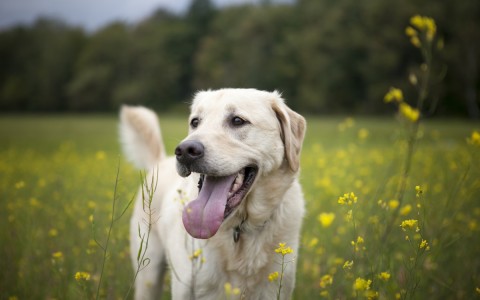News and Notes from The Johnson Center
What Every Child Needs to Know About Dog Safety
JCCHD | Wed, July 22, 2015 |On Saturday, July 18th, The Johnson Center for Child Health & Development had the pleasure of hosting a workshop for kids presented by canine-behavior expert Caitlin Lane, CPDT-KA (Certified Professional Dog Trainer – Knowledge Assessed) from Austin Dog Zone.
In between fun games, a photo booth, story time, and animal crafts, the kids learned proper etiquette and safety tips for approaching and playing with dogs. This is important information for all children to know and practice to ensure their safety at home and in the community.
Caitlin began by explaining that many dogs are friendly, but if you are approached by a dog who makes you scared or uncomfortable, the first thing you should do is to “become a tree.” And how does a person become a tree? You stand with your feet firm (“rooted” in the ground), your arms crossed down in front of you, perfectly still, looking down at the ground. This will confuse the dog and he will most likely leave you alone.

Photo Credit Be-A-Tree.com
If you get knocked over or are already on the ground during this encounter, you should “become a rock.” You can become a rock by curling over with your knees tucked underneath you, facing the ground, with your hands covering your neck, and keeping as still as possible.

Photo Credit DogGoneSafe.com
The kids practiced this throughout the presentation – every time Caitlin would hold up the picture of a snarling dog, the kids would assume the tree or rock position. This practice will help ensure they can employ this skill in the event of an emergency.
Caitlin then went through the steps of how to tell if a dog is friendly and approachable. Caitlin taught the children that we can use our bodies to see if the dog is ready to meet us or not.
Eyes: Use your eyes to look at the dog to see what signs are being given. Does the dog have an open mouth with a panting tongue? This is an indication of a dog ready to play. Is the tail of the dog down and relaxed? This is another sign of an approachable dog. However, if the dog’s mouth is closed, if the ears are back, or the tail is straight up, this indicates the dog is worried or scared and should not be approaced. Another sign of a dog who should be left alone is the “whale” eye, or when you can see the whites around the eye of the dog. If you see a dog begin to yawn (when you know it isn’t tired) or if the dog licks around its mouth and isn’t around food, these are signs the dog is stressed and should be left alone.

Happy Dog Photo Credit Themes.com
Worried Dog Photo Credit MooseysCountryGarden.com
Mouth: Use your mouth to ask your parents if you may approach the dog. If they say yes, use your mouth to ask the dog’s owner if you may approach the dog. If they say no, then you can’t approach the dog. If they say yes, then you can proceed with these steps.
Hands: Use your hand, balled up into a fist, to invite the dog to meet you. Squeeze your hand into a fist and hold it out in front of you. Let the dog come up to smell your fist. But wait for the dog, don’t shove your fist in its face. Put your fist down and low where the dog can check you out. If the dog sniffs your fist and stays near you, then you may pet the dog on the back of the neck or scratch behind their ears. Dogs don’t like hugs or kisses like people do, so show them you like them by respecting their space and giving them the attention they like – scratches on the shoulder area and pats.
Legs: If you encounter a dog who is tied up and can’t get away, don’t approach it. This isn’t fair to the dog. It may feel trapped or scared, and when dogs are trapped and scared they are more likely to bite. So if you come across a dog who is tied up, who demonstrates any of the stress signs listed above, or an owner who says no when you ask if you can pet their dog, then use your legs to walk away.
It is a good idea to practice theses steps with a known, friendly dog to ensure your child has safe habits when it comes to canine encounters. For more information visit Doggone Safe for great tips and photos to help discuss and review this information with your kids. Another great resource with terrific videos is The Family Dog. If your child benefits from using visual cues, watch the videos, then print the photos and make a game of practicing these responses and steps. You can begin by playing pretend, where you are the dog and the child approaches you.
Dogs have long been known to be man’s best friend…now let’s teach our kids to safely be a dog’s best friend.



